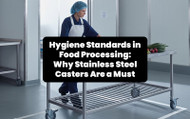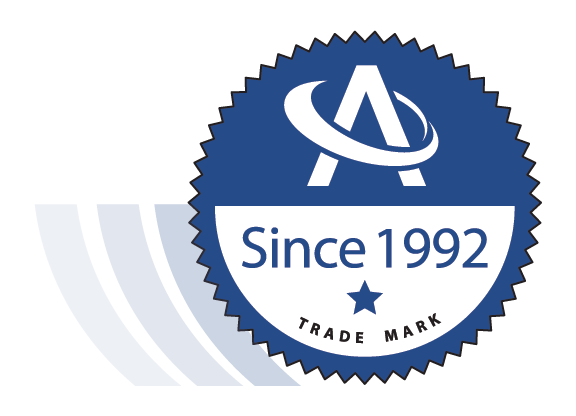Hygiene Standards in Food Processing: Why Stainless Steel Casters Are a Must
Aug 6th 2025
In the food processing industry, hygiene is more than just a standard—it’s a life-or-death factor. From raw materials to the final packaged product, cleanliness impacts everything from the quality of food to public health. Contamination can occur at any stage, and the consequences are severe, affecting not just the integrity of the food but also the safety of the consumers. As food processing operations grow in complexity and scale, maintaining stringent hygiene standards becomes more challenging.
One of the critical areas where hygiene practices must be upheld is in the movement and maintenance of equipment. It’s not just about how clean the surface is but ensuring that every part of the food processing facility is mobile and easily accessible for cleaning. This is where stainless steel casters play a vital role. Casters made from stainless steel are the unsung heroes in food processing plants, offering the mobility and durability needed to navigate the stringent hygiene requirements. They ensure that food processing equipment, such as mixers, ovens, and containers, can be easily moved for thorough cleaning without compromising the hygiene standards that are essential for safe food production.
Stainless steel casters are not only resistant to corrosion but are also easy to maintain, making them a must-have for any food facility that wants to meet regulatory compliance and ensure the highest levels of cleanliness. When you combine mobility with easy-to-clean surfaces, casters stainless steel become the ideal choice for food processing environments, where cleanliness, safety, and operational efficiency are non-negotiable.
Why Stainless Steel Casters Are the Optimal Choice for Food Processing
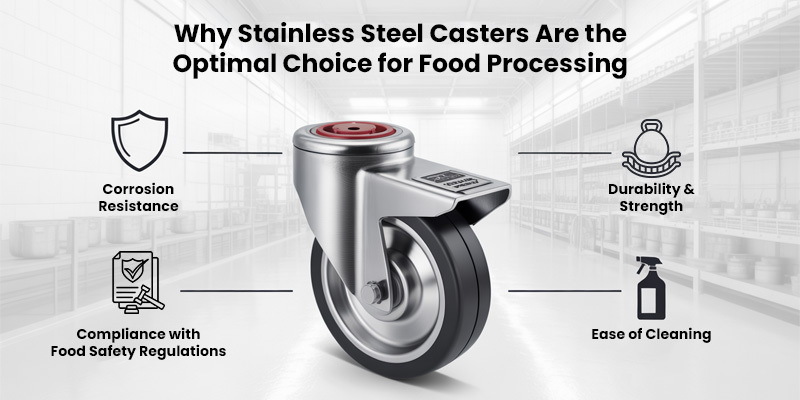
Corrosion Resistance
In food processing environments, equipment is constantly exposed to moisture, high temperatures, and sometimes harsh chemicals. These conditions can quickly degrade materials that aren't designed for such exposure, leading to corrosion and compromising the hygiene of the facility. Stainless steel casters stand out due to their exceptional resistance to corrosion, making them ideal for the food industry.
Stainless steel has a natural resistance to rust and corrosion, which is a critical factor in maintaining the cleanliness of food processing facilities. The material’s ability to withstand constant exposure to water, cleaning agents, and high-pressure washing ensures that casters stainless steel will maintain their structural integrity for much longer than alternative materials. This corrosion resistance also helps prevent bacteria and contaminants from accumulating on the casters, ensuring that the wheels are safe and hygienic, and won’t pose a risk of contamination in food production areas.
For food plants that regularly deal with wet conditions or cleaning procedures that involve chemicals, stainless steel casters provide peace of mind by ensuring longevity and reliability without compromising on hygiene.
Durability and Strength
In addition to their resistance to corrosion, stainless steel casters heavy duty are designed to withstand the demands of heavy equipment used in food processing facilities. Food processing equipment, such as large mixers, conveyor belts, and ovens, can be quite heavy. Casters used in these environments need to not only support significant weight but also maintain smooth mobility for easy maneuvering.
Stainless steel casters offer unmatched strength and durability, allowing them to bear heavy loads without bending, cracking, or breaking down over time. These casters are built to handle the weight and wear-and-tear of large food processing equipment while providing the mobility necessary for cleaning and maintenance. Whether it’s large kitchen appliances or movable storage racks, stainless steel casters provide the support needed to keep operations running smoothly without interruption. This robust durability ensures that stainless steel wheels perform consistently in demanding environments, even when subjected to heavy-duty applications.
Ease of Cleaning
One of the most important factors in food processing hygiene is the ability to clean and sanitize every surface efficiently and thoroughly. Stainless steel casters excel in this area. Unlike rubber or plastic casters, which can trap dirt, debris, and bacteria in crevices or grooves, stainless steel casters have smooth, non-porous surfaces that are easy to wipe down and disinfect.
The ability to clean stainless steel wheels quickly and thoroughly is essential for complying with food safety regulations, as these wheels come into direct contact with food storage containers, processing equipment, and other surfaces in the facility. With their smooth surface, stainless steel casters prevent food particles or bacteria from accumulating, which is a significant concern in food production. Regular cleaning protocols are made simpler, ensuring that the wheels are hygienic and free from contaminants that could otherwise lead to contamination of the food products being processed.
Moreover, stainless steel’s resistance to wear and tear from cleaning agents and abrasive materials makes it more durable than other materials. It does not degrade or discolor under cleaning procedures, ensuring that your food processing equipment stays hygienic and compliant with food safety standards for years to come.
Compliance with Food Safety Regulations
Food safety is one of the most regulated industries in the world, and ensuring compliance with hygiene standards is crucial for avoiding fines, product recalls, and damage to a company’s reputation. Stainless steel casters are an essential part of meeting these stringent requirements. Regulatory bodies such as the U.S. Food and Drug Administration (FDA), the European Food Safety Authority (EFSA), and the U.S. Department of Agriculture (USDA) set clear guidelines for cleanliness and contamination prevention in food processing.
The non-porous surface of stainless steel ensures that bacteria cannot accumulate, and its resistance to corrosion makes it the material of choice in environments where contamination risks must be minimized. Stainless steel casters are specifically designed to meet the hygiene standards set by these regulatory bodies. By using casters stainless steel, food processing facilities can ensure that their equipment complies with the latest health and safety regulations. This level of compliance is critical not only for public safety but also for the ongoing success and credibility of a food processing business.
Additionally, stainless steel casters contribute to a facility's overall sanitation, which is one of the core factors inspected during audits. With the ease of maintenance and cleaning, these casters ensure that a food processing plant remains in compliance, avoiding costly violations or disruptions in operations.
By combining durability, corrosion resistance, and ease of cleaning, stainless steel casters heavy duty provide unmatched value for food processing operations. Their performance in harsh environments makes them the go-to choice for heavy-duty applications where hygiene is a top priority. Whether dealing with extreme conditions or requiring frequent cleaning, stainless steel wheels stand out as the most reliable solution, ensuring both mobility and cleanliness are maintained in food facilities.
The Role of Casters in Maintaining Sanitation in Food Facilities
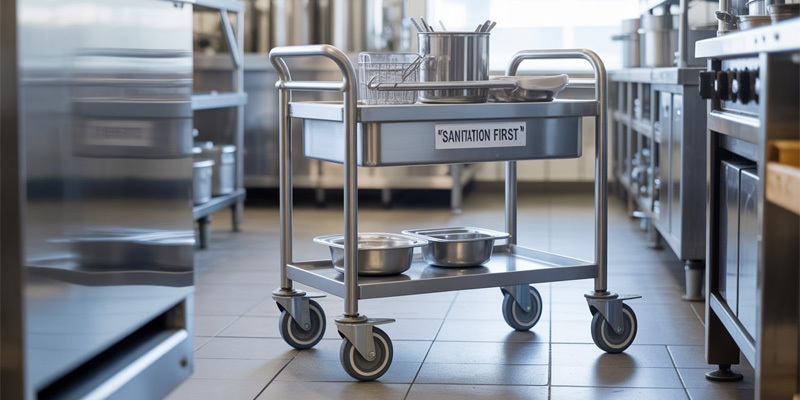
Mobility and Flexibility
In food processing facilities, one of the key challenges is ensuring that equipment can be easily moved to allow for thorough cleaning and maintenance. Casters are an essential component in achieving this goal, offering mobility and flexibility that make it easier to access areas that would otherwise be difficult to reach. Food processing equipment, such as mixers, conveyors, and storage racks, can accumulate dirt, food particles, and bacteria if not cleaned regularly. Without the ability to move equipment efficiently, cleaning efforts are limited, leading to potential contamination risks.
By incorporating casters into food processing equipment, operators can easily move machines and tools to designated cleaning areas. This movement allows for better access to all surfaces, ensuring that no area is neglected. Caster maintenance becomes much simpler as the equipment can be relocated, disassembled, or wiped down without difficulty, keeping the entire facility sanitized and hygienic.
In addition, regular maintenance of the equipment becomes more efficient. Casters make it possible to lift, tilt, or rotate equipment to ensure it is cleaned from all angles. This mobility is a simple yet effective way to maintain hygiene and extend the lifespan of food processing machinery.
Minimizing Contamination
Cross-contamination is a major concern in food processing, where various food products are handled, stored, and processed in close proximity. Casters play a pivotal role in reducing the risk of cross-contamination between raw ingredients, food products, and cleaning areas.
The mobility provided by casters enables workers to move equipment away from food production zones when cleaning or sanitizing. For instance, after a batch of raw food ingredients is processed, equipment with casters can be easily moved to another area to prevent direct contact with other items being processed. This reduces the chances of pathogens from raw food products contaminating cooked or finished items. By providing smooth movement and easy relocation, casters help to keep areas separated, ensuring that bacteria or food debris do not spread from one zone to another.
Moreover, having equipment on casters allows cleaning personnel to use automated or high-pressure washing systems more effectively. Food processing equipment that can be moved out of the cleaning area will be subject to deep cleans that adhere to food safety protocols without compromising the rest of the facility's operations. This mobility ensures that food safety standards are maintained and contamination risks are minimized.
Swivel Casters for Better Maneuverability
The versatility of heavy duty swivel casters is another advantage in maintaining sanitation in food processing environments. Swivel casters are designed to rotate 360 degrees, allowing equipment to be maneuvered in tight spaces and around corners with ease. This flexibility enhances the ease of movement and ensures that large machines, even those with heavy-duty components, can be repositioned quickly during cleaning or maintenance procedures.
The ability to quickly relocate equipment means that the cleaning process becomes less labor-intensive and more effective. Workers don’t need to struggle with stationary equipment; instead, they can simply rotate and reposition heavy machinery to access hard-to-reach areas. This not only saves time but also ensures that cleaning efforts are thorough and consistent across the entire facility.
Furthermore, heavy duty swivel casters are designed to carry the weight of substantial equipment without compromising performance. These casters ensure smooth movement even in facilities where equipment is heavy, such as large food mixers or industrial ovens. With these casters, food processing plants can achieve better workflow while maintaining a high standard of cleanliness. The enhanced maneuverability also prevents wear and tear on floors, which can accumulate dirt and bacteria over time.
The role of casters in food processing extends beyond just facilitating mobility; they directly impact the ability of food facilities to maintain sanitation standards. Proper caster maintenance ensures that the equipment remains in working order and that hygiene practices are consistently followed. By utilizing heavy duty swivel casters, food plants can optimize cleaning workflows, minimize contamination, and meet regulatory standards, all while enhancing the efficiency and mobility of their operations.
How to Choose the Right Stainless Steel Casters for Food Processing Equipment
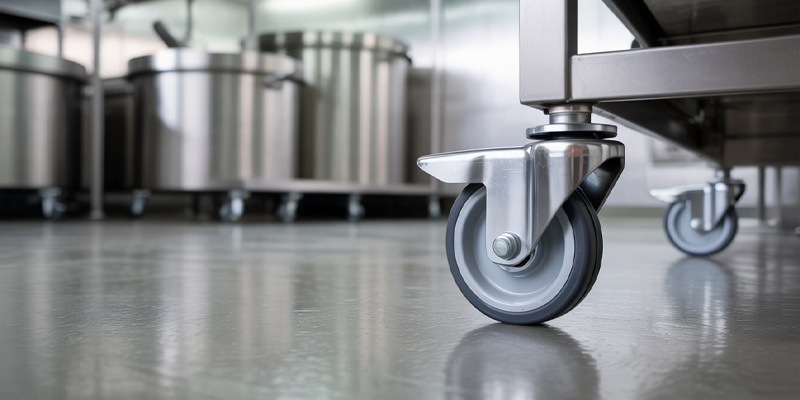
When selecting the right casters for food processing equipment, it’s essential to consider several key factors that will ensure mobility, durability, and compliance with food safety regulations. Stainless steel casters are often the go-to option for these environments, but within that category, there are several different types and features that must be considered for optimal performance.
Factors to Consider
- Load Capacity:
The primary consideration when choosing stainless steel casters is the load capacity. Food processing equipment, especially large machinery like mixers, ovens, and storage racks, can be heavy. Selecting casters with the appropriate load capacity ensures that the equipment can move smoothly without causing damage to the caster or the flooring. Casters that are under-rated for load capacity may fail prematurely, potentially leading to downtime or unsafe conditions.
It’s important to choose casters with a load capacity that exceeds the weight of the equipment they will be supporting. Stainless steel casters heavy duty are specifically designed for heavy loads, ensuring long-term durability and safe mobility. - Resistance to Chemicals:
Food processing facilities often use cleaning agents and chemicals that can corrode other types of casters. Stainless steel is resistant to a wide range of chemicals, including acids, oils, and cleaning agents, making it the ideal material for environments where sanitation is critical. When choosing casters, ensure that they can withstand the types of chemicals commonly used in your facility’s cleaning protocols. - Ease of Cleaning:
Hygiene is paramount in food processing, and equipment must be easy to clean and sanitize. Stainless steel casters offer smooth, non-porous surfaces that resist dirt and food debris accumulation. This makes them significantly easier to clean than other materials, such as rubber or plastic, which may trap contaminants. Casters that are easy to clean reduce the risk of cross-contamination and help maintain food safety standards. - Mobility and Maneuverability:
The equipment in a food processing facility must be moved frequently for cleaning, maintenance, or reorganization. The right casters provide smooth mobility without compromising performance. Consider whether your facility needs casters that can handle quick direction changes, or whether straight-line movement is more common. Swivel kitchen chairs with casters provide exceptional maneuverability, allowing you to easily pivot and relocate equipment without hassle. This is crucial for quick cleaning and flexibility in fast-paced environments.
Different Sizes and Types
Casters come in various sizes, and choosing the right size is essential for both performance and safety. For food processing equipment, here are some key considerations:
- 2 Inch Stainless Steel Casters:
Smaller casters, such as 2 inch stainless steel casters, are suitable for lighter equipment, smaller carts, or mobile workstations. These casters are ideal for smaller food processing tools or equipment that requires frequent repositioning within confined spaces. Despite their smaller size, 2 inch stainless steel casters still offer the durability and ease of cleaning necessary for hygienic environments. - Larger Casters:
For heavy-duty equipment, larger casters with a higher load capacity should be chosen. Equipment like large food mixers, refrigeration units, or mobile storage containers may require casters ranging from 4 inches to 8 inches in diameter or even larger. Larger casters distribute the weight more evenly and allow for smoother movement of heavy items, minimizing wear and tear on floors and ensuring stability during operation.
Choosing the right size depends on the specific equipment’s weight and mobility needs. Larger equipment requires larger casters to distribute the weight and provide a smoother glide across the facility floor, while smaller items can function well with 2 inch stainless steel casters.
Swivel and Fixed Casters
Casters come in two primary types: swivel casters and fixed casters. Each type has its advantages, and selecting the right one depends on the specific needs of your food processing facility.
- Swivel Casters:
Swivel kitchen chairs with casters provide excellent maneuverability, allowing for 360-degree rotation. These casters are ideal for equipment that needs to be moved in different directions or into tight spaces. For example, swivel casters are excellent for mobile food prep stations, equipment carts, or storage racks that need to navigate through narrow aisles or around obstacles. The ability to rotate freely makes them incredibly versatile for food processing environments where flexibility is key. - Fixed Casters:
Fixed casters, on the other hand, allow equipment to only move in a straight line. While they provide less maneuverability than swivel casters, they are often used in situations where equipment only needs to be moved along a fixed path or where stability is more important than maneuverability. Fixed casters are useful in areas where heavy equipment needs to be securely stationed but may need to be repositioned occasionally for cleaning or maintenance.
In many food processing plants, a combination of both fixed and swivel casters is often used to ensure flexibility and stability where needed.
Selecting for Heavy Duty Use
For food processing equipment that deals with substantial weight, it is crucial to select stainless steel casters heavy duty. Heavy-duty casters are designed to carry more substantial loads, which is essential for large mixers, ovens, or industrial refrigerators. These casters typically feature reinforced wheels and stronger mounting brackets, which allow them to handle the strain without compromising performance.
Heavy duty casters made from stainless steel provide the added benefit of corrosion resistance, ensuring that they remain functional in high-moisture or chemically intense environments. These casters also tend to offer a smoother ride and are less likely to fail under the pressure of heavy equipment.
When choosing the right casters for food processing equipment, it’s essential to consider factors such as load capacity, chemical resistance, and ease of cleaning. Whether you need caster wheel casters for light-duty equipment or 2 inch stainless steel casters for smaller mobile units, ensuring the correct size and type of caster is crucial for smooth operations. And for heavy-duty applications, investing in heavy duty swivel casters or stainless steel casters heavy duty ensures your equipment is safe, reliable, and easy to maintain while adhering to food safety standards.
Best Practices for Caster Maintenance in Food Processing
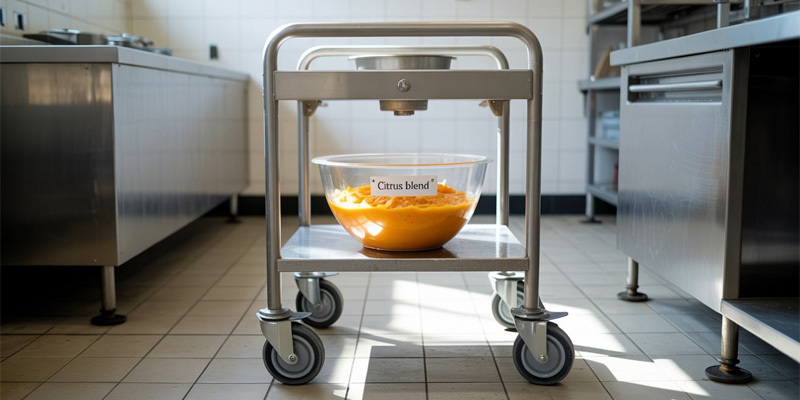
Importance of Regular Caster Maintenance
In food processing facilities, ensuring that casters function optimally is crucial not only for operational efficiency but also for maintaining hygiene standards. Casters play an integral role in facilitating the movement of equipment, storage carts, and machinery within food processing plants. Over time, casters can accumulate debris, become damaged, or even fail due to wear and tear. Regular caster maintenance is vital to prevent these issues and to keep operations running smoothly.
By maintaining casters properly, you ensure that they remain functional, easy to clean, and compliant with stringent food safety regulations. Poorly maintained casters can cause delays in cleaning, increase contamination risks, and even damage the facility’s flooring. Regular maintenance helps extend the lifespan of your casters, improve the overall performance of equipment, and prevent costly replacements or repairs. Establishing a routine maintenance schedule will not only reduce downtime but also help avoid potential hygiene violations, keeping your food processing plant compliant with industry standards.
Cleaning and Sanitizing Casters
The cleanliness of casters directly impacts the hygiene of a food processing facility. Casters that come into contact with raw food, equipment, or surfaces need to be cleaned and sanitized regularly to avoid contamination. Here’s a step-by-step guide on how to clean casters effectively to ensure they remain in good condition:
- Step 1 – Inspect the Casters:
Before cleaning, check the casters for any visible dirt, debris, or damage. Ensure that the wheels are free of food particles, grease, or other contaminants that could be transferred to food products. - Step 2 – Remove Loose Debris:
Use a brush or compressed air to remove any loose dirt, food particles, or debris from the caster wheels. Pay close attention to the areas around the axle and wheel hubs, where particles can often get lodged. - Step 3 – Disinfect the Casters:
Once loose debris is removed, use a disinfectant cleaner that is suitable for stainless steel or the specific material of the caster. Spray the cleaner onto the wheel and its components, and scrub gently with a non-abrasive cloth or brush to ensure all surfaces are cleaned thoroughly. - Step 4 – Rinse and Dry:
After cleaning, rinse the casters with clean water to remove any remaining disinfectant. Use a clean, dry towel or cloth to wipe down the casters, ensuring that no moisture is left behind to prevent rust or corrosion. - Step 5 – Lubricate (If Needed):
If the casters are designed for lubrication, apply an appropriate lubricant to the wheel’s moving parts to ensure smooth operation. This will also help to prevent rusting and reduce friction.
By following these steps and cleaning casters after every shift, food processing facilities can reduce the risk of contamination and ensure compliance with food safety regulations. Cleaning and sanitizing casters regularly also contribute to the longevity of the equipment and the overall efficiency of your operations.
Maintaining Smooth Movement
Smooth movement of casters is essential in a food processing facility, not only for efficiency but also to protect both the equipment and the floor. When casters do not move smoothly, they can damage flooring, increase strain on machinery, and hinder productivity. Here are some tips to help maintain smooth movement:
- Regular Lubrication:
Keeping the moving parts of the casters lubricated ensures that the wheels can rotate smoothly. Apply the correct type of lubricant as recommended by the caster manufacturer to avoid friction that could damage both the casters and the floor. - Clean the Wheel Axles:
The axles of the casters are crucial for smooth movement. If they are clogged with dirt or food debris, they can cause the casters to become stiff. Regularly cleaning the axles as part of your caster maintenance will ensure that they continue to operate smoothly. - Check for Wear and Tear:
Over time, casters can experience wear and tear, especially in high-traffic areas of the facility. Inspect the wheels regularly for signs of damage or uneven wear. Damaged wheels can create resistance, causing difficulty in movement and potentially damaging the floors. - Ensure Proper Alignment:
Misaligned casters can result in poor movement and additional strain on the equipment. Ensure that all casters are aligned correctly and that any issues with caster alignment are addressed promptly.
Maintaining smooth movement through regular lubrication, cleaning, and inspection will keep the casters functioning optimally and prevent operational delays.
Replacement and Repairs
Even with regular caster maintenance, casters will eventually need to be replaced or repaired. It’s essential to know when to take action to avoid potential safety issues or disruptions to your facility’s operations. Here are some signs that it may be time to replace or repair the casters:
- Visible Damage:
If a caster has visible cracks, chips, or is broken, it should be replaced immediately. Damaged casters can compromise the stability of the equipment and may pose safety risks to workers. - Excessive Wear on the Wheels:
Over time, wheels will wear down, particularly in high-traffic areas. If the tread of the wheel is significantly worn, causing uneven movement or damage to floors, it's time to replace the caster. - Reduced Mobility:
If the caster no longer moves smoothly, despite cleaning and lubrication, it may be a sign that the internal mechanisms are worn out and need replacement. - Rust or Corrosion:
While stainless steel casters are resistant to rust, prolonged exposure to harsh conditions or improper maintenance may lead to corrosion. If rust or corrosion becomes noticeable, the caster should be replaced to prevent further damage.
By following proper caster maintenance practices, such as regular cleaning, lubrication, and inspection, you can prolong the life of your casters and ensure compliance with hygiene standards. Knowing how to clean casters effectively and addressing wear and tear early will help prevent costly replacements and disruptions to your food processing operations. Regular maintenance is key to maintaining smooth mobility, extending equipment lifespan, and protecting both your floor and machinery.
FAQs:
- Why are stainless steel casters important in food processing?
Stainless steel casters are crucial for hygiene, mobility, and compliance with food safety regulations in food processing environments. - Are stainless steel casters resistant to corrosion?
Yes, stainless steel casters are naturally resistant to rust and corrosion, making them ideal for wet and chemically intensive food processing conditions. - How do stainless steel casters help reduce contamination?
Their smooth, non-porous surface prevents bacteria buildup and allows for easy cleaning, minimizing contamination risks. - Can stainless steel casters handle heavy food processing equipment?
Yes, heavy-duty stainless steel casters are designed to support large machinery like mixers and ovens without bending or breaking. - Do stainless steel casters comply with food safety regulations?
Absolutely. They help meet sanitation standards set by regulatory bodies like FDA, USDA, and EFSA.
Wrapping Up
Maintaining hygiene standards in food processing facilities is a constant challenge, but choosing the right casters can make a significant difference. Stainless steel casters are essential in addressing common issues such as contamination risk and difficult cleaning processes. Their smooth, non-porous surface prevents the buildup of food particles and bacteria, ensuring that equipment can be moved easily for cleaning without transferring contaminants. Additionally, stainless steel wheels are easier to clean, reducing the labor and time required to maintain hygiene standards in the facility.
By incorporating casters stainless steel into food processing operations, facilities can enhance sanitation efforts, reduce cross-contamination, and ensure compliance with food safety regulations. These durable and easy-to-maintain casters not only improve the hygiene of the facility but also contribute to the overall efficiency of operations.
For food processing facilities looking to improve sanitation and operational efficiency, exploring high-quality stainless steel casters is a crucial step. Consider upgrading your equipment with Atlanta Caster’s stainless steel casters to streamline your cleaning processes, enhance mobility, and meet the high hygiene standards required in food production.




 Email US
Email US
 Hours
Hours
 Visit Our Showroom
Visit Our Showroom


